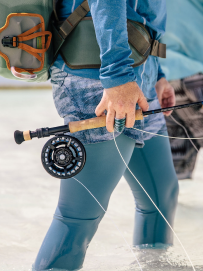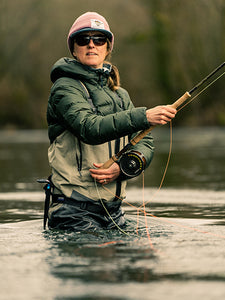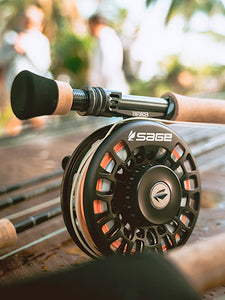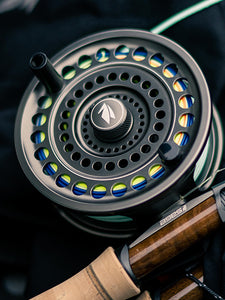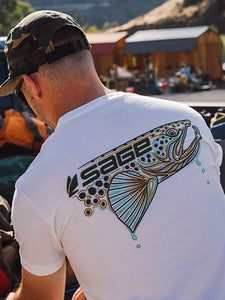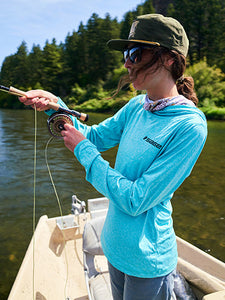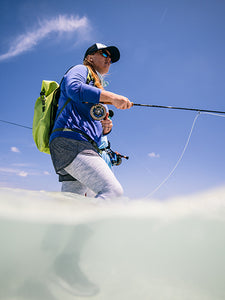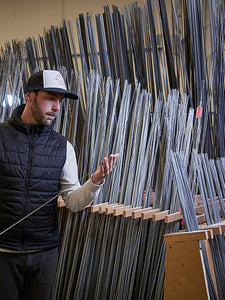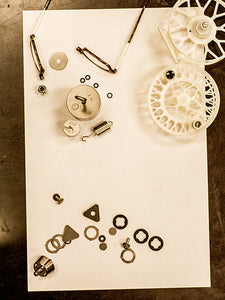
Tasmania
There’s not a lot of land on the planet south of 40° which led to the theory of the great southern continent. With all that land mass above the equator surely the planet had to be balanced out by an equal amount of land mass south of the equator, or so the thinking went. There’s much of New Zealand, the southern ends of Chile and Argentina, a scattering of wildly hostile and remote Islands, (which most of them seem to be called Desolation Island), and that’s about it for south of 40 degrees. Oops, hang on, wait a second, there’s also Tasmania, the often forgotten island south of mainland Australia.
The Tasmanians are sensitive about being left off the map of Australia, but in many ways that’s also served them well, especially the fishermen. They have an outstanding and really unique trout fishery almost to themselves, and in a world where so many trout waters are becoming overwhelmed, they have mostly flown right under the radar.
The Tasmanian trout fishery is a study in the evolution of fly fishing, where the same fish, but the waters, the isolation, and a variety of quite different fisheries and insect life, has led to some pretty unique fly fishing techniques, and of course flies. If you could attribute one major influence on how the locals go about their fishing, perhaps it would be those of the British Isles, particularly the boat-based fishing, but there’s so much more that’s original about how Tasmanians go about their trout fishing; we can learn a great deal from them.


Knowing the substrate goes a long way toward success in this part of the world. In the sheltered rubbly bottomed bays the fish get right up into the skinny stuff hunting mayflies in particular right through their life cycle.

Drifting the slick of a windlane out in the middle of a lake looking for cruisers feeding on terrestrials.
For example, it’s probable that the use of polarized glasses to spot fish cruising in shallow water – so you could present a fly to them – began here, in the lakes of the Central Highlands. Tasmanians are the masters of sight fishing. To Tasmanian fly fishers, blindly flogging wet flies (or any flies for that matter) is on just about the same level as bait fishing. If circumstances do force you into doing it, just keep it to yourself, it’s a private matter. This place is almost all about casting to rising fish and to visibly cruising fish.
To understand a fishery you need some knowledge of the geography of it. The Central Plateau area of Tasmania is all at around 700-1000 meters above sea level and consists mostly of a thousand lakes, large and small, deep and shallow, natural and man-made, easily accessible and very remote. In winter it’s very cold and snow can blanket the plateau.
Each of these bodies of water has its own “personality” determined by substrate, the surrounding countryside, altitude, and catchment. They’re even more different from each other than the creeks and rivers of Montana. Between the lakes are forests, some pasture country, and an open tundra-like landscape in the higher wind swept altitudes. The land up here is rocks, rocks, and more rocks, but the soil between the rocks is very fertile.

Brown trout will have a territorial beat that they consistently cruise. The boundaries of that beat are usually obvious and you can set up an ambush with a dry fly knowing that they’ll be back in a minute or so.

The golden browns of the western lakes are invariably beautifully marked fish.
Most lakes have a self-sustaining population of wild fish - browns, rainbows and in some places brookies, but it’s mostly the brownies that rule these waters. These are the descendants of the first trout to be brought to the Southern Hemisphere and their origins are Loch Leven in Scotland. They have some tough and wily genes.
Broadly the fishing has two long arms that in turn branch off into various fingers. These are bank fishing and boat fishing. Loch style and wind lane fishing from boats is very popular. I can tell you that it’s something very special in mid-summer to see big golden browns and pods of bright rainbows feeding in the middle of the day off the top way out in the middle of a windblown lake.
The mid-summer period produces prodigious quantities of terrestrials, a variety of beetles in particular, but also grasshoppers, cicadas, flying ants and a host of other edibles. These accumulate into wind blown lanes and froth lines that form with consistent wind direction and strength. Boats ply the windlanes using electric motors and zig zag back and forth across these features to intercept surface feeding fish. Ten foot rods - #6 weights are preferred- and a team of up to three dry flies on a 20 foot leader are laid like a minefield across the path of feeding fish. It’s spectacular fishing that can continue well on into winter when the midge hatches take over, and what seems like a million rainbows begin to feed in the deeper, darker forested lakes of the west coast. The western coast of the island is where the ‘roaring forties’ hit their first bit of land since way back in Patagonia. It is one of the wettest places on the planet and is dense, with utterly impenetrable temperate rainforest.

Chris Bassano sets up an interception with an early season trout cruising the very shallowest edges looking for frogs.

Sometimes the very faintest ripples reveal a fish to those who are atuned to what’s going on. In the very skinny glassy water early in the day its what you look for. It won’t be anything but a trout and it will be feeding.
On the shoulders of the mid-summer period is the mayfly and caddis season. October and November before summer, and in February and March, they start up again. There’s a variety of mayflies and caddis, and exceptional local patterns have them covered. Most like to fish emergers. The mayflies are usually large in mayfly terms, 12’s and 14’s will get you by and you’ll very rarely have to resort to 16’s or smaller. The trout here are particularly partial to a stick caddis pattern and, along with mayfly nymphs, scud, frogs, tadpoles and snails, they hunt these in very skinny water on the margins of many of the lakes.
It’s invariably sight fishing, either to tailing (early in the morning), rising, or cruising fish. This is technical fishing to match the toughest spring creek fishing on the planet, especially if your fly is subsurface and a fish is very slowly mooching along munching things. You usually have to strike on instinct or look for the very faintest movement of the tippet.
Suspending a stick caddis just a few inches under a dry at least gives you an indicator and a double bet. This is very different from having the luxury of a fish holding in the current, rising rhythmically to a passing flotilla of insects. There’s no allowance here for drifting a fly down into a fish’s feeding line, you need to predict where its going to go and land the fly very delicately in front of it, usually in only a few inches of water, and then that fly has to just sit there stationary and intercept a fish that might be slowly wandering like a fat kid in a candy shop searching for a favourite.


Tassy lowland mayflies are invariably large, 12 and 14 are the most imitated.
A classic shallow water rig with a stick caddis suspended under a dry- there’s usually only a few inches between the indicator and nymph.
It is without question the most difficult trout fly fishing I have encountered, and if you think you’re good, well there’s nothing like an early morning session on “the untouchables” shore at Little Pine Lagoon to deflate your notions of your abilities.
Mayfly time on many lakes is ridiculously good fishing. Tasmanian browns do have a tendency to look up most of the time, so in mayfly season, even when the mayflies aren’t hatching, they’re still looking around and will happily eat a nondescript dry fly. Many of the lakes are shallow, often no deeper than 8 feet. They can vary in size from late winter snow melt puddles to many miles in circumference.
Some are rich with weedbeds, some are rocky; they’re all very different and all fish differently, and need to be approached differently. Walking the shoreline, in the further-out tarns beyond the ends of the roads, and especially on a calm blue sky day, can produce the very best fishing. This is Champagne stuff, particularly when the black spinners are swarming along the warm lees of the bush clad shorelines.
A classic early season, early morning brownie feeding right in along the shallowest edges. The margins for a good presentation are extremely fine.


Corners of lakes with a clear sand bottom are like gold on a cloudy day.
For the boat fishing a 9’6” or 10’ rod is ideal. I can’t imagine a better rod than the 6100 X and this is a very popular rod in that part of the world for this type of fishing. My preferred line on this is RIO’s Single Handed Spey line. I use the larger CLICK reel (4/5/6 size) much of the time but have also become very partial to the SPECTRUM LT in the 5/6 model. For shore-based sight fishing on a calm day, I like a 9 footer and the 590 MOD has my vote as the finest trout rod out there in trout land.
So if you’re feeling comfortable and complacent with where you’re at with your fishing, it might be time to get out of your comfort zone and get humbled a bit. Travel a bit further and discover this island that lies in the roaring 40’s with its unique and prolific wildlife, its essential emptiness, and some really different trout fishing. There are rivers there too, but that’s another story.
A hump backed, deep shouldered, heavily marked Tasmanian Highlands brownie.
About the author
Peter Morse is a Sage Ambassador residing in Australia. He is the author of two books, "Saltwater Fly Fishing Fundamentals" and "A Few Great Flies... And How to Fish Them", and is also an FFI Master Casting Instructor. For more information on Peter, see www.wildfish.com.au


